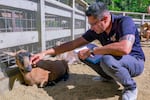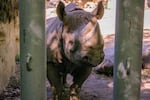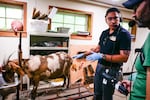
Dr. Carlos Sanchez, the head veterinarian at the Oregon Zoo, visits with Roxanna, a Nigerian dwarf goat at the Trillium Creek Family Farm at the Oregon Zoo, Aug. 18, 2023.
Sheraz Sadiq / OPB
As the head veterinarian, Dr. Carlos Sanchez is ultimately responsible for the health and well-being of more than a thousand animals — not including the fish — at the Oregon Zoo in Portland. He starts the day by leading a morning meeting with veterinary staff to discuss checkups, treatments and exams of patients who can’t say where it hurts. And even if they could, the survival of the fittest favors hiding signs of illness or weakness that could prove fatal in the jungle or on the savannah.
“Although they live in a zoo under human care, they are wild animals and they do tend to hide disease in the wild,” Sanchez said. “An animal that is sick is not going to make it, it will be prey … Also, if there is something serious inside, we sometimes do not see any clinical signs until it’s pretty advanced.”
Fortunately, the zookeepers play a critical role in alerting Sanchez and his veterinary team to any early signs of distress or illness. The daily rounds help the animals develop familiarity with medical staff and cooperate during routine exams or procedures.

Chendra, a female Bornean elephant at the Oregon Zoo, stands next to elephant keeper Aimee Bischoff during a visual exam performed by Oregon Zoo head veterinarian Dr. Carlos Sanchez on Aug. 18, 2023.
Sheraz Sadiq / OPB
“We like to have that relation not only with the keepers, but with the animals too,” Sanchez said as elephant keepers Gilbert Gomez and Aimee Bischoff coaxed over Chendra, one of the zoo’s resident elephants, with a bucket of sweet potatoes.
“They can say, ‘open mouth,’ and she would show her mouth,” Sanchez said. “So we don’t have to sedate them. Everything is relatively a good experience for the animals.”
Chendra is the zoo’s only Bornean elephant, and along with her smaller size, is clearly recognizable from the other elephants roaming the habitat.
“You can see she has hairy ears, and this subspecies is more hairy than the other Asian elephants,” Sanchez said.

Chendra, a female Bornean elephant, stands next to elephant keeper Aimee Bischoff during a visual exam performed by Oregon Zoo head veterinarian Dr. Carlos Sanchez on Aug. 18, 2023.
Sheraz Sadiq / OPB
Chendra is one of Sanchez’s favorite patients. Still, he said, constant vigilance is required when examining an animal as massive as an elephant to avoid being hurt. Sanchez recalled a story of treating a baby elephant years ago at the Smithsonian’s National Zoo in Washington, D.C.

Chendra, a female Bornean elephant at the Oregon Zoo, gets a treat of bok choy from elephant keeper Aimee Bischoff during a visual exam performed by Oregon Zoo head veterinarian Dr. Carlos Sanchez on Aug. 18, 2023.
Sheraz Sadiq / OPB
“The female developed a little bit of what we call edema,” Sanchez said. “I was checking her and I’m between her legs … and one of the keepers is like, ‘Watch out.’ So I’m looking at what leg she’s going to kick me with, or she’s moving, and she just defecates ... on the top of my head and because I wasn’t ready, it just basically hurt my neck.”
“I had to go to the doctor, actually,” he said, “and obviously I had to take a shower, too.”
In 2000, the National Zoo accepted Sanchez into its highly competitive three-year residency program, making him the first Latin American veterinarian to be accepted for a zoo medicine residency in the U.S.

Dr. Carlos Sanchez, the head veterinarian at the Oregon Zoo, talks with "Think Out Loud" host Dave Miller outside the elephant enclosure at the Oregon Zoo on Aug. 18, 2023.
Sheraz Sadiq / OPB
“You can be a vet, but then to be a zoo vet is actually rather difficult. And in the United States, particularly for an immigrant, it is harder because I had to learn veterinary English, not just English,” he said.
Sanchez credits a fateful childhood encounter with a baby giant panda that would change his life and set him on the journey to pursue zoo medicine. Tohui, the first giant panda born outside of China to survive to adulthood, was born at the Chapultepec Zoo in Mexico City in 1981. Sanchez said the zoo capped admission at 100,000 visitors a day due to the demand to see the panda.
“I remember as if it was yesterday, we probably were in line for three or four hours just with my mom, my sister and my brother,” Sanchez said. “I saw this panda for 25 seconds … and I was like, ‘I want to work with these animals.’”
So he did. In fact, Sanchez spent five years working with the very same panda who captured his heart at the zoo before she died of an illness at the age of 12. He has also helped care for giant pandas during his residency in Washington, D.C., and traveled to China multiple times to train veterinarians at a panda breeding center.
Although he no longer gets to regularly interact with his “dream animal,” there is another species at the Oregon Zoo he considers his favorite these days.
“I love rhinos. I always say they are like a safe box with legs,” Sanchez said. “They are massive, but they are also super smart … And I am attracted to species that have conditions that are harder to diagnose or animals that are harder to anesthetize.”

King is a male Black rhinoceros who arrived at the Oregon Zoo in September 2021. He is shown in this photo taken on Aug. 18, 2023 standing near the entrance to the enclosure which he shares with Jozi, a female Black rhino.
Sheraz Sadiq / OPB
The zoo has two black rhinoceroses — Jozi and King — who arrived at the Oregon Zoo in 2021 from different zoos in the Midwest. Their personalities are as different as night and day, according to Sanchez.
“King is the male, but he is not the king. (Jozi is) the queen. He is literally like a puppy … you can scratch him, you can touch him, you can pinch his cheeks. She is a handful,” Sanchez said. “They now actually love each other and I can say that because they don’t like to be apart,” he added.

Jozi, a female black rhino, walks in her enclosure at the Oregon Zoo on Aug. 18, 2023. She shares the enclosure and is bonded with King, a male black rhino, who also arrived at the zoo in 2021.
Sheraz Sadiq / OPB
The hope is the pair breed, which would be welcome news for the conservation of a species that is critically endangered, with only about 6,000 black rhinos remaining in the wild.
Finishing his rounds for the day, Sanchez observed the sheer diversity of the zoo’s animals — exotic and domestic — and the range of procedures and checkups they require, such as annual tuberculosis testing for Sonia, a Nubian goat, inside the Family Farm exhibit.
“We have goats. We have rabbits. We have guinea pigs. We have some tortoises … Sometimes we joke that, you know, it’s nice to work with animals that do not want to kill you,” Sanchez said.

Dr. Carlos Sanchez, head veterinarian at the Oregon Zoo, talks with "Think Out Loud" host Dave Miller during an exam he performed on Sonia, a Nubian goat, at the Oregon Zoo on Aug. 18, 2023.
Sheraz Sadiq / OPB
By the afternoon, the zoo buzzed with activity: Children sprinted by to get a closer look at a polar bear wading into an icy pool; smartphones snapped selfies; parents steered strollers with napping toddlers dreaming perhaps of pink-plumed flamingos or willowy giraffes. Sanchez reflected on the dozens of species coexisting within this space, a community of different personalities and proclivities, much like human society.
“I always tell people a zoo is like a city,” he said. “We have elderly citizens. We have citizens that may not do well. We have infants, we have all these kinds of people with different habits and they eat something different. And for me, I see it like that and ... I actually like to teach people, and particularly when you see somebody interested in the job we do.”
Carlos Sanchez spoke to “Think Out Loud” host Dave Miller. Click play to listen to the full conversation:
